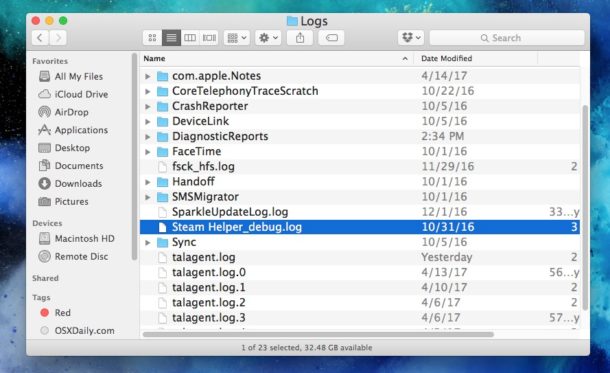What are log files, and what do they do?
Your gadget suddenly slows down. One of the side-effects of malicious software is a slow gadget.
Log files are a journal of system parameters and entries describing everything that takes place on your Mac. Any operation that is being performed is noted down in the form of logs, much like a “black box” on an airplane.
For the most part, log files contain crash reports and app errors. To us, regular users, this information bears no sense because it’s unreadable. But when you need to diagnose a problem, log files are an indispensable invention.
How to delete user log files?
Why would anyone want to delete user logs on Mac? First, deleting outdated logs may speed up some of your apps. Second, however small they are, logs still take space on your disk. And lastly, outdated logs could potentially cause software conflicts.
User logs are a part of your user profile.
They are stored at: ~/Library/Logs
You should know that deleting user logs is not an everyday operation. It may backfire if you don’t know what you’re deleting. But since you asked, here is how it’s done.
We've got two ways to do it: the manual way and the CleanMyMac X way.
How to clear log files on a Mac manually
Signs that your computer has been hacked. If you think your computer has been hacked, and have Norton installed on your computer, the best option to rule out a threat infection is to perform a full system scan. However, there may be instances where the scan did not detect any threat, or you cannot perform a scan. If the Mac is running Lion or above, type the following commands instead, changing the username and new password accordingly: You should now be able to access your Mac without restrictions. Part 3: Protecting your Mac from Mac OS X Password Bypass. As you can see, it is really easy to hack into your own Mac. Consequently, a generic icon is used by Apple in the “Displays” section of “About This Mac”, and in the “Displays” section of “System Preferences”. Many people will wish to change this to an image of their specific external display model. 1) Open a Finder window, and navigate to the System folder. At Mac's login screen, an untrusted user can also use the root trick to gain access to a Mac that has FileVault turned on to make unauthorized changes to the Mac System Preferences, like disabling FileVault. All the untrusted user needs to do is click 'Other' at the login screen, and then enter 'root' again with no password.
- Open Finder and select 'Go to Folder' in the Go menu.
- Type in
~/Library/Logsand hit Enter to proceed to this folder (pay attention to the use of “~” — this will ensure that you’re cleaning user log files, not the system log files). - Optional step: You can highlight & copy everything to a different folder in case anything goes wrong.
- Select all files and move them to the Trash.
- Restart your Mac.
Note: We recommend that you remove the insides of these folders, but not the folders themselves. Also, note that some system applications, like Mail, have their own logs stored elsewhere.
Make sure that once you have finished clearing out these logs for additional hard drive space, you empty your Trash. To do this, Control-click on the Trash icon in the dock and select “Empty Trash.” Restart your Mac afterward so your Mac can begin to create new log files.
System Log Mac Hacked Version
Also, some log files can be found in the /var/log folder, but not all the items contained therein are safe to remove. That’s why it is safer to remove log files using a Mac cleaning utility like CleanMyMac X.
How to clear log files with CleanMyMac X
Rather than searching all over your Mac for log files yourself, you can clean up logs with CleanMyMac X in just 4 steps. And that’s not all it does!
Here's how to delete log files on a Mac with CleanMyMac X:
- Download CleanMyMac X (free version) and launch it.
- Choose System Junk in the left menu.
- Click Scan at the bottom of CleanMyMac X.
- Hit Clean.
Done! If you’d like to remove only log files and nothing else, click Review Details before clicking Clean. Deselect everything except for System Log Files and User Log Files, and then click Clean.
Is it safe to delete log files?

Many experienced users prefer to clean their user logs as part of their Mac cleaning routine. Though it doesn’t directly translate into speed, there is some benefit in keeping your disk clean. Some apps have notoriously large log files, especially media apps. For example, I’ve found a single log file by Elmedia player that weighted 325 MB in writing this article.

You shouldn’t delete the entire Logs folder, only delete what’s contained inside as a word of caution. As we have said, log files serve diagnostic purposes. If your Mac is doing well, there’s nothing particularly harmful in deleting logs.
Cleaning up log files with CleanMyMac X is as easy as can be. And, as we said before, it can do so much more, too! With CleanMyMac X, you can clean up outdated apps, language packs, universal binaries, and gigabytes of useless junk you didn’t even know you had. Download CleanMyMac X now and feel what it’s like to have a faster, cleaner Mac.
What are log files, and what do they do?
Log files are a journal of system parameters and entries describing everything that takes place on your Mac. Any operation that is being performed is noted down in the form of logs, much like a “black box” on an airplane.
For the most part, log files contain crash reports and app errors. To us, regular users, this information bears no sense because it’s unreadable. But when you need to diagnose a problem, log files are an indispensable invention.
How to delete user log files?
Why would anyone want to delete user logs on Mac? First, deleting outdated logs may speed up some of your apps. Second, however small they are, logs still take space on your disk. And lastly, outdated logs could potentially cause software conflicts.
User logs are a part of your user profile.
They are stored at: ~/Library/Logs
You should know that deleting user logs is not an everyday operation. It may backfire if you don’t know what you’re deleting. But since you asked, here is how it’s done.
We've got two ways to do it: the manual way and the CleanMyMac X way.
How to clear log files on a Mac manually
- Open Finder and select 'Go to Folder' in the Go menu.
- Type in
~/Library/Logsand hit Enter to proceed to this folder (pay attention to the use of “~” — this will ensure that you’re cleaning user log files, not the system log files). - Optional step: You can highlight & copy everything to a different folder in case anything goes wrong.
- Select all files and move them to the Trash.
- Restart your Mac.
Note: We recommend that you remove the insides of these folders, but not the folders themselves. Also, note that some system applications, like Mail, have their own logs stored elsewhere.
System Log Mac Hacked Client Windows
Make sure that once you have finished clearing out these logs for additional hard drive space, you empty your Trash. To do this, Control-click on the Trash icon in the dock and select “Empty Trash.” Restart your Mac afterward so your Mac can begin to create new log files.
Also, some log files can be found in the /var/log folder, but not all the items contained therein are safe to remove. That’s why it is safer to remove log files using a Mac cleaning utility like CleanMyMac X.
How to clear log files with CleanMyMac X
Rather than searching all over your Mac for log files yourself, you can clean up logs with CleanMyMac X in just 4 steps. And that’s not all it does!
Here's how to delete log files on a Mac with CleanMyMac X:
- Download CleanMyMac X (free version) and launch it.
- Choose System Junk in the left menu.
- Click Scan at the bottom of CleanMyMac X.
- Hit Clean.
Done! If you’d like to remove only log files and nothing else, click Review Details before clicking Clean. Deselect everything except for System Log Files and User Log Files, and then click Clean.
Is it safe to delete log files?
Many experienced users prefer to clean their user logs as part of their Mac cleaning routine. Though it doesn’t directly translate into speed, there is some benefit in keeping your disk clean. Some apps have notoriously large log files, especially media apps. For example, I’ve found a single log file by Elmedia player that weighted 325 MB in writing this article.
You shouldn’t delete the entire Logs folder, only delete what’s contained inside as a word of caution. As we have said, log files serve diagnostic purposes. If your Mac is doing well, there’s nothing particularly harmful in deleting logs.
Cleaning up log files with CleanMyMac X is as easy as can be. And, as we said before, it can do so much more, too! With CleanMyMac X, you can clean up outdated apps, language packs, universal binaries, and gigabytes of useless junk you didn’t even know you had. Download CleanMyMac X now and feel what it’s like to have a faster, cleaner Mac.